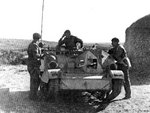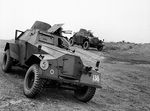Boys Anti-Tank Rifle
| Country of Origin | United Kingdom |
| Type | Anti-Tank Rifle |
| Caliber | 13.900 mm |
| Capacity | 5 rounds |
| Length | 1.575 m |
| Barrel Length | 910.000 mm |
| Weight | 16.300 kg |
| Rate of Fire | 10 rounds/min |
| Range | 90.000 m |
| Muzzle Velocity | 747 m/s |
Contributor: C. Peter Chen
ww2dbaseThe Boys anti-tank rifles were the invention of Captain H. C. Boys of the British Small Arms Committee, who was also a designer at the Royal Small Arms Factory, Enfield, London, England, United Kingdom. The original name was Stanchion, but the design was renamed to honor the designer as he passed away only a few days before the design's approval in Nov 1937. The bolt action anti-tank rifles were heavy but were very effective against tanks the Germans fielded earlier in the war. Later in the war, however, the British (and other Commonwealth personnel) found that the Boys anti-tank rifles lack ample power to punch through thicker armor on newer tanks, therefore many of these anti-tank rifles became weapons against bunkers, machine gun nests, and armored vehicles. In Asia and the Pacific, however, Boys anti-tank rifles remained effective through the end of the war, as Japanese tanks did not improve in terms of armor since 1941. At times, they were also mounted on British Universal Carrier tracked vehicles as an alternative to typical Bren light machine guns.In addition to British and Commonwealth forces, some Chinese Army, United States Marine Corps, and Finnish Army personnel also used Boys anti-tank rifles. A number of them, captured after the British withdrawals from France and Norway in 1940, were also in German service.
The Boys anti-tank rifles were manufactured by the Royal Small Arms Factory between 1937 and 1943. About 62,000 units were built.
Near the end of the war, a round capable of greater velocity was designed for use with Boys anti-tank rifles, allowing penetration of the thicker armor found on new German tanks. Since the entrance of these new rounds was so late, however, they were relatively insignificant in the outcome of the war.
Source: Wikipedia. ww2dbase
Last Major Revision: Nov 2007
Photographs
 |  |  |  |
Você gostou deste artigo ou achou este artigo útil? Se sim, considere nos apoiar no Patreon. Mesmo USD $1 por mês já vai longe! Obrigado. Por favor, ajude-nos a espalhar a palavra: Fique atualizado com WW2DB: |
Pesquisar WW2DB
Notícias
- » US Government Plans to Purge WW2 Information (17 Mar 2025)
- » WW2DB's 20th Anniversary (29 Dec 2024)
- » Wreck of USS Edsall Found (14 Nov 2024)
- » Ver todas as notícias
Estatísticas Atuais do Site
- » 1,166 biographies
- » 337 events
- » 44,601 timeline entries
- » 1,243 ships
- » 350 aircraft models
- » 207 vehicle models
- » 376 weapon models
- » 123 historical documents
- » 261 facilities
- » 470 book reviews
- » 28,551 photos
- » 375 maps
Citação Famosa da 2ª GM
"All that silly talk about the advance of science and such leaves me cold. Give me peace and a retarded science."Thomas Dodd, late 1945
Apoie-nos
Por favor, considere nos apoiar no Patreon. Mesmo R$1 por mês já faz uma grande diferença. Obrigado!
Ou, por favor, nos apoie adquirindo alguns produtos do WW2DB na TeeSpring. Obrigado!